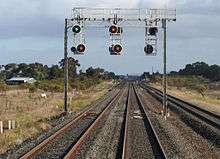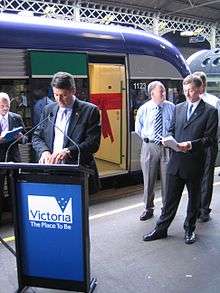Regional Fast Rail project
The Regional Fast Rail project (or RFR project) was a rail transport project of the State Government of Victoria, Australia undertaken between 2000 and 2006 aimed at improving the passenger services on the Victorian regional railway network (operated by V/Line), specifically to reduce travel times, enhance service frequency and safety.
Despite initial setbacks and criticism, by 2009 the project had a legacy of success. Record passenger numbers and a substantial contribution to the growth of regional Victorian economies have both been attributed to the project[1] with several substantial spin-off projects and subsequent calls for further upgrades and investment.
History
Before the 1999 State election in Victoria, the Labor Party under Steve Bracks promised to “kick start the development of more frequent, competitively priced, fast rail to regional centres [through the] consideration of the feasibility of more frequent, competitively priced, fast rail".[2]
Project overview

Part of the Linking Victoria program, the Regional Fast Rail project was launched by the governing Victorian Labor government on 5 September 2000 and described by Transport Minister Peter Batchelor as "the biggest project we've probably seen in Victorian rail in decades",[3]
The fast rail initiative included 5 key components:
- Upgrading rail infrastructure: construction works would be undertaken to upgrade rail infrastructure to allow trains to travel safely at speeds of up to 160 km/h on the country sections of the corridors
- New fast trains: a total of 29 new VLocity trains were to be purchased
- Installation of fibre optic cable: a new fibre optic cable network was to be installed as part of the upgraded rail signalling and communications systems
- New timetable: a revised 2006 V/Line timetable would be developed, incorporating some faster and several additional train services
- Interconnecting bus services: a package of improvements to connecting bus services to the fast rail regional centres[4]
The delivery of these objectives entailed upgrading 500 km of rail lines from the track bed up, installing 400 new and upgraded railway signals, installing more than 460,000 concrete sleepers, upgrading 170 level crossings, introducing new rail safety systems (later including the Train Protection & Warning System), developing new train timetables with improved services, and the laying of new fibre optic cable along the rail corridors to allow for better signalling and also provide enhanced broadband facilities in regional areas.
Launch and services
The VLocity trains began running at increased speeds from December 2005, with 160 km/h services beginning on the Geelong, Ballarat, and Bendigo lines on 3 September 2006.
As well as reduced journey times, the new timetables also increased the frequency of services, with off-peak trains arriving up to once per hour. Additional trains, with varying consist lengths to suit demand, were also scheduled to operate during the peak, with one service on each line in the morning and evening peaks designated as the "flagship" service, which was scheduled to run at the journey time which had been promised.
Ballarat line
Ballarat was the first line to see V/Line's new VLocity in service on 22 December 2005.[5]
Track and signalling was upgraded to allow for VLocity trains running at 160 km/h between Deer Park West Junction and Ballarat. In addition, some deviations were built to ease curves or, in one case, to provide a considerably shorter route (the original route was retained, however, to provide a passing loop).
Geelong line

Fast Rail services were officially launched on the Geelong line on 3 February 2006.[6]
The double-track Geelong line had the track and signalling upgraded to allow for VLocity trains running at 160 km/h between Werribee and Geelong. These works were carried out in various stages between 2004 and 2006. The Geelong line already comprised two bidirectional tracks between Newport and North Geelong. 160 km/h operation is only provided for on the East track for down trains and the West track for up trains.
Bendigo line
Track and signalling was upgraded on the Bendigo line to allow for VLocity trains running at 160 km/h between Sunbury and Bendigo. Also, bidirectional signalling was provided between Sunbury and Kyneton. Between Kyneton and Bendigo the double-track line was singled to allow for better clearances past heritage structures, although retaining some sections of double track to form long crossing loops. The crossing loops were provided with bidirectional signalling, but only one of the two tracks was upgraded for 160 km/h running.
Traralgon line
Track and signalling on the Traralgon line was upgraded to allow for VLocity trains running at 160 km/h between Pakenham and Traralgon. Bidirectional signalling was also provided on the double-track sections between Pakenham and Bunyip, and between Longwarry and Moe. 160 km/h services began on 15 October 2006, although a few selected services ran to slightly faster schedules for a week or so beforehand.[7] However, only the former up track (now called the South track) was upgraded for 160 km/h running; VLocity trains are limited to 130 km/h on the former down track (now North track).
Criticisms
Criticisms of the project centred on the cost, the lack of promised time savings, and the removal of one track from part of the Bendigo line. The Liberal State Opposition of the time dubbed it the "Farce Rail Project".[8]
Costs
The Government originally hoped that most of the cost of the project would be borne by the private sector with a taxpayer investment of A$80 million. However, when this support failed to materialise,[9] the Government decided to pay for the entire A$550 million project. In addition the project ran overtime and over budget with the eventual cost estimated at A$750 million.[10]
Time savings
The original promise was for trains to run to Geelong in 45 minutes, Ballarat in 60 minutes, Bendigo in 80 minutes, and Traralgon in 90 minutes.[4] However, this was soon changed to add four minutes to each journey. In the 2007 V/Line timetables, it takes the Traralgon service 111 minutes to the city.[11]
However, even these times were only for a few trains each day that would run express between Melbourne and the respective regional cities. Furthermore, the number of trains that would run to these schedules was cut to one each way each day.[12] Even though most journey times are now faster than before the project, the public impression is that time savings are minimal.[13]
By 2011, successive timetable changes had drastically slowed services. The Ballarat line alone at least 10 minutes has been added to the average journey following the decision to remove "flagship" express services by the Baillieu Ministry.[14][15]
Bendigo line singling
Although the early plans were altered to allow for longer crossing loops on the single track sections,[16] the removal of one of the existing two tracks from much of the Bendigo line reduced the its capacity and the timekeeping of train services. The resulting delays were added to by delays affecting trains on the metropolitan section of the line between Watergardens and Southern Cross (Melbourne) stations. The installation of broad gauge sleepers, rather than gauge-convertible sleepers which would allow later conversion to standard gauge, was also the source of much criticism.[17]
A spokesman for the Better Rail Action Group claimed that the reason for not upgrading both existing tracks, rather than being for technical reasons, as was stated.[18]
Broadband access
The promised spin-off, broadband access to communities such as Ballan and VLine commuters, did not eventuate due to the government's unwillingness to fund breakout points.[19]
A further criticism is the lack of provision for Wi-Fi on the trains themselves for business travellers.[20]
Legacy
Patronage

Despite some initial setbacks, by 2009 the project was being hailed as an unexpected success, spurring record passenger numbers and substantially contributing to the growth of regional Victorian economies.[21]
Additional trains
Additional trains and carriages were purchased to cope with increasing demand in 2008 and 2009.
Extensions and Upgrades
The success of the initial project paved the way for the inclusion in the Victorian Transport Plan of extensions constructed to accommodate services to Ararat; the new Wendouree Railway Station; services to Maryborough.
Additionally strong calls were made in 2010 to extend it also to Shepparton.[22]
Regional Rail Link
Another legacy of the Regional Fast Rail project is the A$4 billion Regional Rail Link project[23] which aims to separate regional trains on the Geelong, Ballarat, and Bendigo lines from suburban rail movements in the Melbourne metropolitan area. This is designed to increase the reliability and frequency of trains to and from Melbourne on the regional rail network.
See also
- High-speed rail in Australia
- Rail transport in Victoria
- Operation Phoenix
- New Deal
- Regional Rail Link
References
- ↑ Dowling, J; Puchalski, N Regional rail travel booming, despite delays The Age 6 June 2009
- ↑ Rebuilding the transport network, A better transport network for all Victorians, Fast rail links to regional Victoria. Australian Labor Party. 1999.
- ↑ "ABC - 'Fast rail or rail farce'". 8 September 2006. Retrieved 2007-07-26.
- 1 2 "Delivering regional fast rail services" (PDF). Results of special audits and other investigations. Victorian Auditor-General's Office. Retrieved 2012-10-21.
- ↑ "V/line - First Day of VLocity Revenue Operation (Ballarat)". Retrieved 2007-07-26.
- ↑ "V/line - First VLocity Services to Geelong". Retrieved 2007-07-26.
- ↑ "DoI media release - 'NEW GIPPSLAND RAIL TIMETABLE TAKES OFF TODAY'". Retrieved 2007-07-26.
- ↑ "The Age - 'Equipment blamed for train troubles'". Melbourne. 29 March 2007. Retrieved 2007-07-26.
- ↑ "DoI media release - 'EXPRESSIONS OF INTEREST CALLED FOR ON FAST RAIL PROJECT' - May 31, 2001". Retrieved 2007-07-26.
- ↑ "The Age - 'Fast trains strike costly sound hitch'". Melbourne. 11 October 2005. Retrieved 2007-07-26.
- ↑ "V/Line Eastern Region Timetables". Retrieved 2007-07-26.
- ↑ "V/Line Timetables". Retrieved 2007-07-26.
- ↑ "The Age - 'Riding the rails'". Melbourne. 13 September 2006. Retrieved 2007-07-28.
- ↑ McIlroy, Tom. Ballarat commuter anger: V/Line drops express The Courier. 25 April 2011
- ↑ Nolan, Pat (2012-11-20). "New V/Line timetable sends some commuters' days off track". The Courier. Retrieved 2013-04-15.
- ↑ "DoI media release - 'LONG DOUBLE TRACK SECTIONS TO PROVIDE FOR HIGH-QUALITY SERVICES ON BENDIGO RAIL LINE'". 17 November 2003. Retrieved 2007-07-26.
- ↑ "Bendigo Better Rail Action Group". Retrieved 2007-07-28.
- ↑ "Andrew McLean - Single-minded Mania" (PDF). Retrieved 2007-07-28.
- ↑ http://www.abc.net.au/local/stories/2008/07/09/2298907.htm
- ↑ Price, Nic [Internet call for V/Line rail services] Melbourne Leader. 19 July 2010
- ↑ Dowling, Jason; Puchalski, Natalie (6 June 2009). "Regional rail travel booming, despite delays". The Age. Melbourne.
- ↑ http://www.sheppnews.com.au/members/login.aspx?noaccess=1&from=/article.aspx?id=1177305. Missing or empty
|title=(help) - ↑ "Regional Rail Link". Department of Transport, Victoria. Archived from the original on 21 March 2009. Retrieved 2009-05-15.